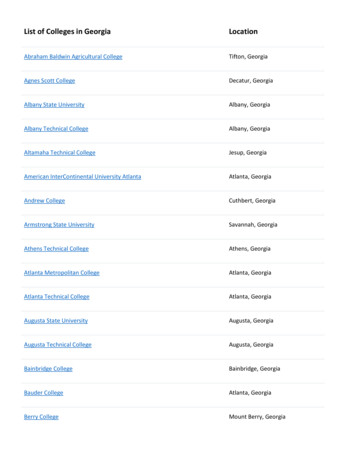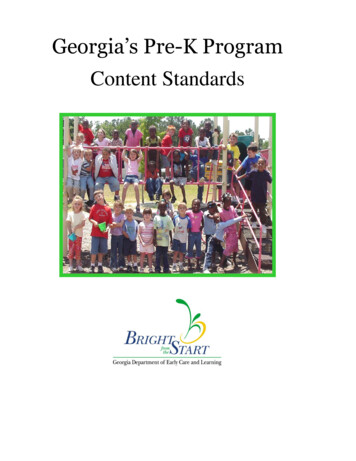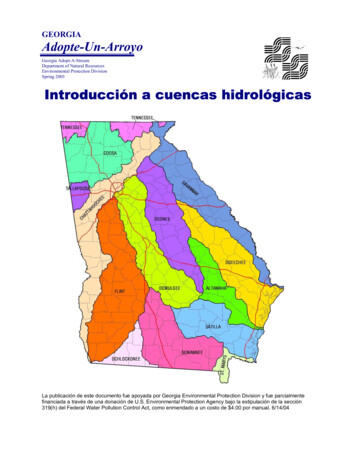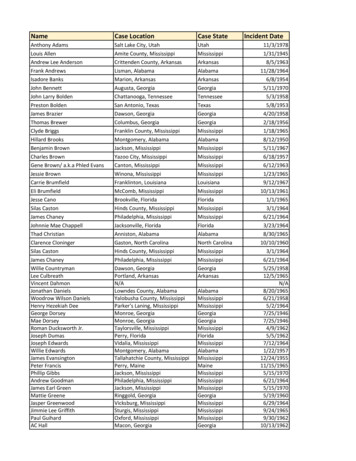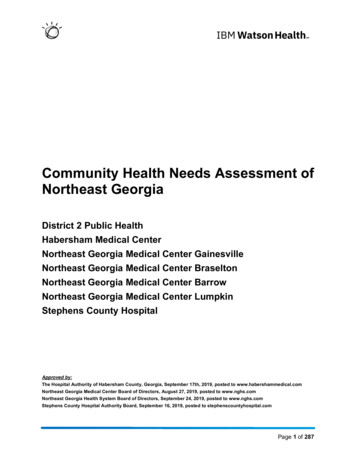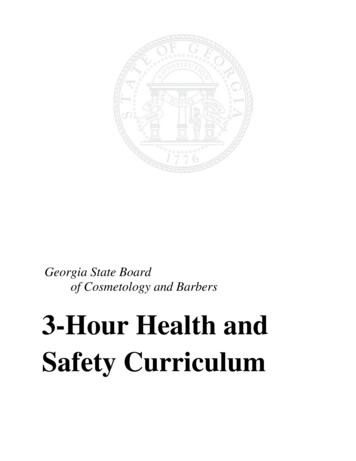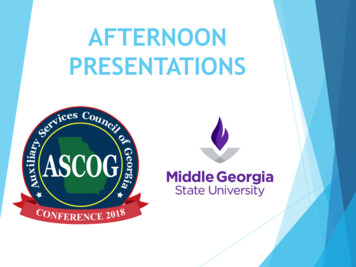
Transcription
Putting the pieces together. to save livesGeorgia Poison Control2014 Annual Report
Our mission is to provide high quality poisoncontrol center services to healthcareprofessionals and residents of Georgia. It isour goal to deliver prompt and accurate poisoninformation to those who access our services.We continuously strive to: Educate residents of Georgia in the areas of poison prevention and first-aid Educate health-care professionals in the areas of clinical toxicology, poisoningepidemiology, poison prevention, toxicological diagnosis and care Provide stable and continuous delivery of quality poison control centerservices to Georgians
Georgia Poison ControlThe Georgia Poison Centerreceived calls from all 159Georgia counties. The chartto the left demonstratesutilization from each countyon a calls-per-capita basis.The counties with the mostfrequently reported humanexposures were Fulton, Cobb,Gwinnett, DeKalb, Muscogee,Chatham, Cherokee, andHenry.According to national data, in2013 America’s 55 poisoncenters received over 3.1million calls. Of those, about2.2 million were calls abouthuman poison exposures.
AGE 6 Years6-12 Years6.78%13-19 Years7.33%27.91%20-59 Years7.29% 60 YearsUnknown ChildUnknown AdultUnknown Age46.09%0.18%3.60%0.81%Of our 71,391 human exposure calls, nearly half of theminvolved children less than 6 years of age. Pediatricaccidental poisonings continue to represent a significantproportion of calls to the GPC. Children ranging from one totwo years of age make up nearly 30% of all exposure calls.Pediatric exposures usually involve substances that arereadily accessible and commonly found at home. In youngchildren particularly, personal care products (such ascosmetics, dental products, shampoo, and perfume) are themost frequent sources of exposure, while analgesics (painkillers) fall in second place (even though analgesics arereported most commonly in adults).INTERESTINGFACTSPoisonings can happen toanyone. Did you know -Every 30 seconds, childrenare exposed to a potentialpoison!- In Georgia, the situationwhere adults take a double doseof the same medicine has beenincreasing each of the past 3years.
SITE OF CALLERRestaurant/Public Area ther/Unknown5.26%Residence69.77%The majority of calls to the Georgia PoisonCenter come from either the home or fromhealth care facilities. Parents call the GPCwhen they believe their child was exposedto a toxic substance. Seniors call us whenthey fear they may have made an error intaking their medication. Doctors, nurses,and pharmacists from all practice settingscall us for treatment advice on drug orpoison related cases.GPC MANAGESPATIENTS SAFELY ATHOMEA call to the Poison Center provides a rapid,individualized, cost-effective answer to poisonexposures, and often avoids expensive trips tothe Emergency Department or doctor’s office.The operating costs of the Poison Center arepaid by State and Federal dollars, in recognitionof the utility of the Poison Center.Most of the cases handled at the GPC can beeffectively managed at home with treatmentadvice and instruction regarding symptoms ofconcern. All of our calls are handled by highlytrained, experienced, and dedicated healthprofessionals (such as doctors, nurses,pharmacists. And other poison specialists).SITE OF EXPOSURENUMBERPERCENTManaged At Home45,56963.8%Managed in Healthcare Facility23,26632.5%Other/Unknown1,7332.4%Refused Referral8231.2%71,391100%TOTAL
ROUTE OF 88%Ocular2,8593.78%8891.18%Other/UnknownThere are several different ways poisons canenter the body. How a person is exposed to apoison is called the “route of exposure.” Themost common route of exposure to poisonsubstances is through eating or drinking(ingestion).Did you know that an injection is a possibleroute of exposure? Biological or chemicalsubstances can be injected into the body byaccidentally puncturing the skin with acontaminated needle or other sharp device.CIRCUMSTANCES56,45112,268 1,5441,128Unintentional exposures account for 80percent of all human exposures. Theseexposures include occupational orenvironment exposures, bites/stings,therapeutic errors, misuse of products, andfood poisoning.Intentional exposures, due to misuse, abuse, orsuicide attempts, accounted for 17 percent ofour total exposures. Prescription and over the countermedicines are used everyday by teensand adults to “get high”. Studies showthat a large percentage of abusedprescription drugs are obtained withoutpermission from family and friends.Medicines are easily accessible in homemedicine cabinets, closets, pantries,purses, luggage, and etc. and are highlysusceptible to misuse and/or abuse.
SUBSTANCES INVOLVED IN POISONINGSThe most common products involved in poisoning exposures were categorizedas drugs or non-drugs. A patient may be exposed to more than one substance.Of all exposures reported to the GPC, 79 percent of the cases involved drugs and 14percent were non-drug related. For the remaining 7 percent, we were unable todetermine what substance they were exposed to.DRUG SUBSTANCESNON-DRUG SUBSTANCESEXAMPLESNUMBERPERCENTAnalgesics (pain killers)MOTRIN , TYLENOL IN , AMBIEN 4,8865.72%Antihistamines (allergy relief)ALLEGRA , BENADRYL 3,7934.44%AntidepressantsWELLBUTRIN , CYMBALTA 3,5714.19%Cardiovascular DrugsTopical PreparationsLIPITOR , NIASPAN BENGAY , NEOSPORIN 3,4772,666NUMBERPERCENTCleaning Substances (Household)6,1077.17%Cosmetics/Personal Care Products5,5656.54%Bites and Envenomations3,9764.67%Foreign 1,3651.60%4.07%3.12%Cold and Cough PreparationsMUCINEX , DELSYM 2,3512.75%Stimulants and Street DrugsADDERALL , RITALIN 1,9882.33%Antimicrobials 1,3601.60%Anticonvulsants (antiseizure drugs)PHENYTOIN , GABAPENTIN 1,8072.12%Plants1,2101.42%
TREATMENTS INVOLVEDIN POISONINGSOUTCOMES74.91%The two tables below list decontamination techniques(methods to reduce contact with the poison) and othertherapies for poisonings recommended by the GPC during2014. Most patients were managed with dilution,irrigation, or s, IV4,006Other2,924Food/Snack3,469Fresh Air2,171Charcoal, single dose1,876Oxygen1,426Cathartic(substance that accelerates elimination of feces)1,416Antibiotics1,101Other Emetic(induce vomiting)781Whole Bowel Irrigation(flushing out the stomach and intestines)63Lavage(cleansing of a hollow organ)36Charcoal, multiple dose31Ipecac(medicine that causes lator626Antiemetics516NAC, IV478Antihistamines4464.42%0.08%Patient outcomes are graphically illustratedabove. Over 84 percent of our cases resulted (orwere expected to result) in no effect or minoreffects for the poison victim. These findings areconsistent with what other centers are reportingin their data. Additionally, there were 60 casesreported to the GPC that resulted in death (0.08percent of all cases) in 2014.
PUBLIC AND PROFESSIONAL EDUCATIONThe Georgia Poison Control is known for being an emergency telephone service that helps those who havebeen poisoned. It is also known for the education efforts that are put forth to the entire state of Georgia.Our public education efforts are intended to help increase the awareness of poison prevention and tocommunicate how to reach us for a poison emergency or poison information.The Georgia Poison Control and partner organizations provided speakers and/or materials for over 150programs, reaching more than 8,000 people during 2014. During the third week in March, the GeorgiaPoison Center celebrates National Poison Prevention Week (NPPW) and coordinates poison preventionactivities throughout the state in collaboration with pharmacies, hospitals, schools, child care providers,and other agencies concerned with the health and safety of their communities.In 2014, the GPC provided 15 emergency preparedness classes to over 300 participants across the statewith a targeted audience of physicians, nurses, paramedics, pharmacists, and other health careprofessionals who are first responders to hazardous incidents. Classes offered included: Advanced HazmatLife Support (AHLS); Explosion and Blast Injuries; Chemical, Biological, Radiological, Nuclear andExplosive Fundamentals (CBRNE); Nuclear Plant Emergency Response (NPER); and RadiologicalPreparedness and Emergency Response (RPER).The Georgia Poison Control is also a training site for health care professionals. Emergency medicine andpediatric residents from Emory University School of Medicine train at the GPC on an ongoing basis.During their training, these residents have the opportunity to see how a poison center operates, becomefamiliar with the resources that are available in the center, and assist in consulting on poisoned patientsadmitted to local health care facilities. Fourth year pharmacy students from PCOM, Mercer University,and the University of the South are also trained here. Students are introduced to the topic of clinicaltoxicology through one-on-one tutorials and hands-on activities with the guidance of toxicologists andcertified specialists in poison information.
RESEARCH PRESENTATIONS ANDPUBLICATIONS A buzz for a buck anyone? Fatal leukoencephalopathy associated with chronic borate ingestion Pediatric exposures to topical preparations containing methyl salicylate Pediatric ingestions of duloxetine – what is a “safe” dose? Measuring increasing complexity of cases of a regional poison center Neurologic complication of a massive acetaminophen overdose in a toddler Parachuting a compounded transdermal analgesic cream: A leap of faith Massive lacosamide overdose treated with continuous renal replacement therapy Pentobarbital toxicity after somnasol exposure Succimer vs. CaNa2 EDTA for lead encephalopathy in two individuals exposed to lead-contaminatedmoonshine Inappropriate fomepizole administration results in unnecessary cost, easily avoidable Severe hyperkalemia caused by salt substitute ingestion in a child
GEORGIA POISON CONTROL STAFF 2014DirectorGaylord P. Lopez, PharmD, DABATAssistant DirectorStephanie L. Hon, PharmD, DABATMedical DirectorRobert J. Geller, MD, FAAP, FACMTAssociate Medical DirectorBrent W. Morgan, MD, FAAEM, ACMTAssistant Medical DirectorZiad N. Kazzi, MD, FAAEM, FACMTAssistant Medical DirectorAdam Pomerleau, MD, FAAEMAssistant Medical DirectorStella Wong, DO, FAAEMMedical ToxicologistsToxicology FellowsSpecialists in Poison Information (SPIs)Information Technology StaffData ManagerEducation StaffExecutive AssistantsPublic Health Professionals
For any information regarding the Georgia Poison Controlplease contact us at:Georgia Poison Center80 Jesse Hill Drive, SEP.O. Box 26066Atlanta, GA 30303-30501.800.222.1222 poison emergencies404.616.9000 general inquirieswww.georgiapoisoncenter.org
Chatham, Cherokee, and Henry. According to national data, in 2013 America's 55 poison centers received over 3.1 million calls. Of those, about 2.2 million were calls about human poison exposures. Georgia Poison Control


